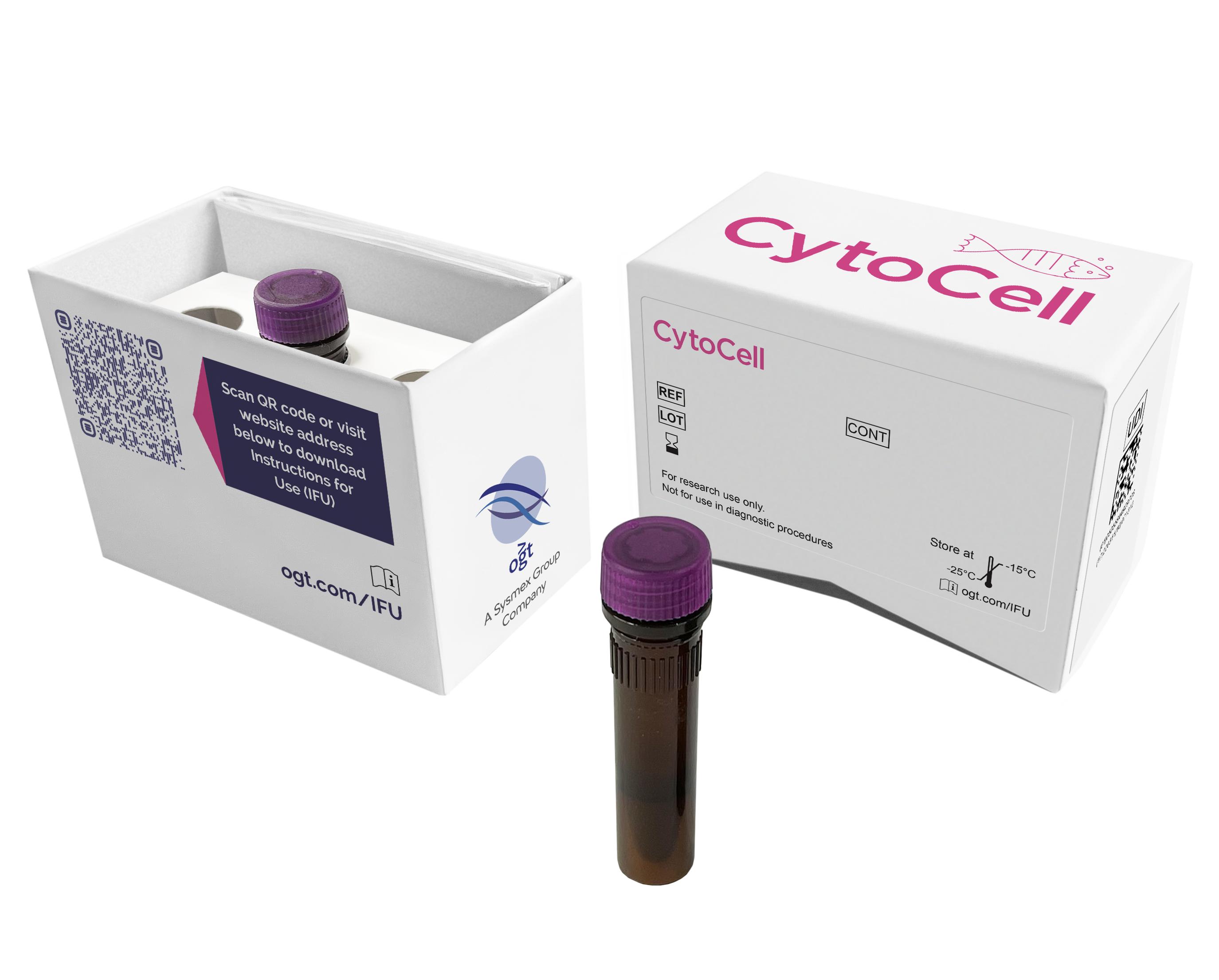
The SHOX probe is 137kb, labelled in red and covers a region including the entire SHOX gene and flanking DNA on chromosomes Y and X. The probe mix also contains control probes for the X centromere (DXZ1) labelled in blue, and for chromosome Y (DYZ1, the heterochromatic block at Yq12) labelled in green.
The SHOX (Short stature Homeobox-containing gene) is located in the pseudoautosomal region (PAR1) of chromosomes X and Y, in bands Xp22.33 and Yp11.321.
The gene encodes a transcription factor of 292 and 225 amino acids (SHOXa and SHOXb respectively), whose translated proteins differ in the C-terminal regions. SHOX is a cell-specific homeodomain protein involved in cell cycle and growth regulation and activates transcription in osteogenic cells2. SHOX haploinsufficiency is involved in the aetiology of idiopathic short stature and the short stature observed in Turner syndrome3. Homozygous loss of the SHOX gene has been correlated with Langer type mesomelic dysplasia. Subsequently, heterozygous SHOX mutations were also shown to cause Leri-Weill dyschondrosteosis4.
The incidence of SHOX deficiency is between 1 in 2000 and 1 in 5000 in the general population and between 1 in 40 and 1 in 150 in short people5,6.
In vitro diagnostic (IVD)
→ English/Français/Italiano/Deutsch/Español
→ Polski
Research use only (RUO)
Find certificate of analysis documentation for our CytoCell FISH probes
Our lab has been using a wide range of CytoCell FISH probes for a number of years, and have been increasing this range all the time. The probes have clear bright signals and show good reproducibility. CytoCell provides fast delivery of catalogue probes, and are very responsive when we have any queries or problems with their products.

Bridget Manasse
Addenbrookes Hospital, Cambridge University Hosiptals NHS Foundation Trust, UK
In our hands, CytoCell FISH probes have proven to be of the highest quality with bright, easy to interpret signals, thus providing confidence in our results. OGT's customer support is outstanding, as their staff are extremely knowledgeable and truly care about their customers and their customers’ needs.

Jennie Thurston
Director of Cytogenetics, Carolinas Pathology Group, USA
I first came across CytoCell FISH probes in a previous lab I worked in and I was struck by the quality of the products. Since this time, I have been recommending and introducing CytoCell probes across all application areas — now they are the primary FISH probes used in our lab. They have an excellent range of products and their ready-to-use reagent format saves considerable time.

Elizabeth Benner
Medical Technologist, University of Arizona Health Network, USA
We have been working with CytoCell fish probes for two decades because of their excellent clarity and intensity regardless of the size of the probe. It is so clear and simple to detect.
Dr. Marina Djurisic
Head of Laboratory of Medical Genetics, Mother and Child Health Care Institute of Serbia “Dr Vukan Cupic”, Serbia
The quality and consistency of CytoCell’s probes means I can trust the results, and my clients get their results in a timely manner.

Dr. Theresa C. Brown
Director, Cytogenetics Laboratory, Hayward Genetics Center, Tulane University School of Medicine, USA
It was very important for us to have more consistent results with our probes — easy-to-read bright signals and a range of vial sizes, which is much more cost-effective.

Janet Cowan, PhD
Director of the Cytogenetics Laboratory, Tufts Medical Center, USA
Not only do CytoCell offer an extensive range of high-quality FISH probes, the customer support is also excellent — providing fast access to all the probes I need. The probes are highly consistent with bright signals allowing easy scoring of results.
Dr. Eric Crawford
Senior Director, Genetics Associates Inc., USA
The quality and reproducibility of results using the CytoCell kit has been vital in accurately detecting co-deletions in our glioma investigations. We now have a cost-effective test that we can rely on that is also easy to use and interpret. We've been consistently impressed with this kit - not to mention the support offered by OGT's customer service, and have completely transitioned over to CytoCell probes.
Gavin Cuthbert, FRCPath
Head of Cancer Cytogenetics, Northern Genetics Servce, Newcastle, UK